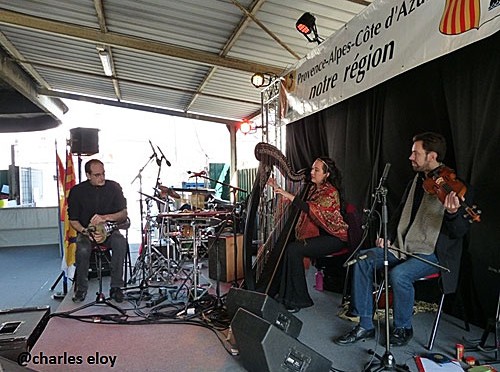On Saturday night, most of the bands were French to please the general public. The crowd around was younger on average than in the previous nights. Some just wanted to be there to get a buzz and jumped up and down on the faster songs, while talking throughout the quieter ones.
Trio Keynoad appeared on stage representing the Provence Alpes – Côte d’Azur region. The members of Trio Keynoad are Ameylia Saad Wu (voice and harp), Christian Kiane Fromentin (violin, saz) and Nicola Marinoni (percussion).
Ameylia is the daughter of Lebanese writer Michel Saad and a Chinese mother. The group’s lyrics are poems by Ameylia’s father set to music. She grew up on Reunion Island and quickly became interested in learning the Celtic harp and classical singing.
The song “Follow your star” featured a steady darbuka beat. We easily recognized the Eastern structure of the song containing intervals of three-quarter tones.
The remaining songs ‘Okinanoss “Sega islands” and “Night Wings” invited us to a journey in space and time. A mixture of neo-classical and world music.
The next performance I attended at the Chapiteau stage was Compagnie Lyakam ((India – France). Jessie Veeratherapillay performed Bharata Natyam, the dance of her Tamil ancestors. It’s a form of Indian classical dance expressing grace, purity, and sculptural poses.

The musicians on electric sitar, saxophone and percussion, together with vocal harmonies, delivered jazz and flamenco flavors.
Soadaj, from Reunion Island (France) brought a breath of fresh air at the Salle des Sucres. The musicians specialize in Maloya that is, along with the Sega, one of two major genres of Reunion.

Pan-African and European influences are mixed into their music reflecting the melting pot of the band.
On “Out ‘Po” the crystalline voice of the blonde singer Marie invaded the space, supported by the sound of the didgeridoo, plunging us into a shamanic trance. The voice of Laurence, the second singer in counterpoint, harmony or response fitted completely into the music of the band.
The musicians of Saodaj were full of beauty, talent and youth, with a solid background and life experience. They brought us authenticity and the enthusiastic reception of the public was fully justified.
Belgium-based duo Vardan Hovanissian (Armenia) & Emre Gültekin (Turkey) played at the Cabaret stage. Vardan Hovanissian plays duduk, an Armenian music instrument like a double reed oboe, while Emre Gültekin plays the saz, a long-necked lute.

Both musicians brought into life the coexistence of two cultures that existed under the Ottoman Empire until the tragic events of the early 20th century with the physical elimination of about 1.5 million Armenians.
Vardan Hovanissian and Emre Gültekin produced a duo album “Adana“, one hundred years after the beginning of the Armenian genocide.

The title song “Adana” is dedicated to Adana, a city which housed a large Armenian community in the late 19th century and was exterminated during the genocide. Emre’s voice expressed suffering.
“Daglar” (mountain in English) is a poem written by Emre’s father. Emre sang softly. The accompaniment by the darbuka and the saz created a sense of emptiness on mountain tops. Vardan and Emre were supported by two experienced musicians mastering the Turkish and Armenian music structures based on Eastern and Western scales.
The concert by Vardan Hovanissian & Emre Gültekin ended with a standing ovation of more than 1,500 persons.
The band 7SON@TO that performed at Salle des Sucres is the flagship of gwoKa, the musical style Guadeloupe of island. It is mainly played with drums of different sizes called ‘ka’, a family of percussion instruments.

On stage, a lead singer in the center, 3 singers (two women and one man) and four percussionists.
Durg the song “Péyi Dewo” a singer took over the lead vocals. Then other musicians, and part of the audience responded. “Ah Ta Mama Yayo” had growing harmonies. I recognized Central African words in the Creole songs. Indeed, gwoka was born during the period of slavery and was a means of escape and communication. The audience accompanied the songs and danced to the vibes of the Caribbean Isles.
I found that the representation was a bit too pedagogic, but 7SON@TO brought into light their traditions rooted in our time. Their concert enriched me with their culture.
I hope that the coverage of more than one third of the acts gives you an idea of the new discoveries and highlights. Babel Med Music is, without question, one of the important international events in world music. We were very lucky with music and Mediterranean sunshine.
Read parts 1 and 2:
The Cultural Richness of Diversity Showcased at Babel Med Music 2016 – Day 1
The Cultural Richness of Diversity Showcased at Babel Med Music 2016 – Day 2


